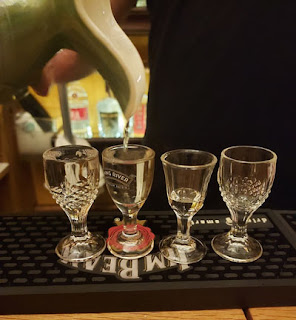
But what is baijiu besides the world's most popular spirit where total production is greater than that of vodka plus whiskey combined? It is a Chinese grain spirit of sorghum and sometimes rice and other grains in the mash bills, and it is produced from a wild ferment of airborne microbes that gives the spirit terroir or a very region-specific feel. The name itself means bai="white" + jiu="spirit," and it is one of the oldest distilled liquors known to man. Its precursor was shaojiu or "burnt water," and this spread to Korea and Japan as soju and shochu, respectively. Alcohol production dates back around 9000 years in China, and this pre-dates the cultivation of wild rice; it is possible that rice crops came about as a way to produce more alcohol. Baijiu is often fermented in lined pits in the ground, and the oldest provable distillery was set up in 1573 and is still producing today (baijiu production started earlier than this date by a few centuries though). Unlike most traditional spirits, the fermentation work is done by a combination of yeast, mold, and bacteria in a single step (unlike sake which is fermented in two steps with mold followed by yeast). A starter called qū of microbes growing on wheat or steamed rice is used to start the fermentation. One study found more than fifty types of mold in the mix, so lots of variations in microbes and thus flavor is possible. The stills are short, squat, and alembic-like but unique in design, and the stills also function as grain steamers. Finally, blending is a major part of the art to target the desired flavor profile.


Style 2: Light Aroma: Unlike the former category, the light aroma baijiu are made from sorgum, and the style originated more to the north. Nick paired this sample with latiao which are gluten pieces soaked in chili oil and coated with chili dust and MSG. My tasting notes for the spirit were "waxy texture, earthy, grain, savory, soy aroma; funky grain, fruit, and soy taste."
Style 3: Strong Aroma: This style originated in Sichuan in the Southwest of China, and it is made with multiple grains yielding complex flavors and aromas. Nick served this sample with Lay's Mala Barbecue potato chips to capture the numbing and spicy food style that would be traditionally paired with this class of baijiu. Indeed, this spirit could match the intense food for my notes were "overripe tropical fruit, durian, pineapple, guava in front; barnyard funk, fermented hay, Brettanomyces-influenced natural wine on end." The oldest distillery is Luzhou Laojiao meaning "old hole in the ground" and makes Ming River brand; check out Camper English's photos and tour on Alcademics. Many of these pits are over 50-100 years old, and they are never fully emptied; perhaps to keep consistency for sour mash and perhaps to generate additional flavors akin to Jamaican rum.
Style 4: Sauce Aroma: This one is Nick's favorite, and it originated in the landlocked province of Guizhou/Kweichow to the Southwest; this has historically been one of the poorest provinces in China that has suffered from a series of famines. Moreover, it is where Nick was living. Frequently, it is made from a combination of sorghum and wheat. Here, the spirit was matched with pickled mustard greens. Sauce aroma style lives up to its name for it is replete with umami and is rather soy sauce like. My tasting notes were "shiitake, cocoa powder, soy sauce, toasted sesame."
While baijiu lives up to the name of "white spirit," some of the stronger flavored and aromatic ones are aged in neutral clay or porcelain vessels to induce oxygenation and concentration. Rice aroma have short fermentation times of around a week, light and strong aroma spend 2 weeks to over a month, and sauce aroma can be over 9 months. Again, there are other styles including medicine aroma where herbs are added in the fermentation such as mugwort, licorice root, and star anise. And the most unusual sounding was phoenix style aged in wicker baskets sealed in bee's wax and pig's blood (no one opted for this one, but if I weren't a vegetarian, I would have requested it. And perhaps curiosity would have gotten the better of me if it was placed in front of me). The additional baijiu that I requested to taste off the shelf was Mei Kuei Lu Chiew which had rose petals in a gin vapor basket-like contraption, and this was delicious and floral. Chu Yeh Ching Chiew was a sweet yet medicinal one from a bamboo leaf infusion that I passed up to try the rose one.

Over the last almost 4 months, Nick has taken up to 18 guests a night via three sittings of 5pm, 7pm, and 9pm around 3-4 Thurdays a month. 10% of the ticket price and all the proceeds from the sale of mugs (a donation from Ming River Baijiu) become a donation to the Boston Chinatown Neighborhood Center. Nick picked this charity for it funds the local community that includes 80% Chinese immigrants. The charity does a lot of work with children with kindergarten and pre-K classes, and after school tutoring, mentoring, and snacks for the older students such that their parents can work. For adults, they sponsor English language courses and job training opportunities.
To learn more about the Boston Baijiu Bar, follow it on @bostonbaijiubar on Instagram or bostonbaijiubar-at-gmail.com on email. Use the app's messaging function or the email address to make reservations.
 The 2017 collection of 855 drink recipes, bartender tributes, and essays on hospitality from CocktailVirgin's Frederic Yarm. Available at
The 2017 collection of 855 drink recipes, bartender tributes, and essays on hospitality from CocktailVirgin's Frederic Yarm. Available at  The 2012 collection of 505 drink recipes, techniques, and Boston bar recommendations from Frederic Yarm. Available at
The 2012 collection of 505 drink recipes, techniques, and Boston bar recommendations from Frederic Yarm. Available at 





No comments:
Post a Comment